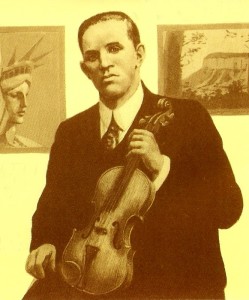James Morrison was born at Drumfin, close to the village of Riverstown, Co. Sligo, on the 3rd May 1893. Drumfin and the surrounding areas were amongst the strongest musical localities in County Sligo with the fiddle and flute taking prominence. Frank Morrison, James’ father, was a small farmer while making his main living as a builder and carpenter in the local area.
Frank married Margaret Dolan from nearby Lackagh, in 1879, and James, known as Jim, was the second youngest of their eleven children, five girls and six boys. Jack Dolan, Jim’s grandfather came originally from Drumkeerin in Co. Leitrim, an area noted for its traditional musicians and dancers, before relocating to Lackagh in the mid-1800s.
Morrison was born into a thriving musical community and his older siblings Tom and John were already fine musicians in his youth and were amongst his earliest influences. In fact, it was on Tom’s concert flute that James Morrison was to make his first musical endeavours. Neighbouring fiddler Tom Johnston also played a special role in his developing fiddle playing but the musician said to have had the greatest influence on his early musical endeavours was travelling Piper Johnny Gorman from Derrylahan, on the Mayo-Roscommon border who was a regular visitor to Drumfin during Morrison’s youth. Gorman was also a noted influence on the musical development of Morrison’s Sligo and New York contemporary Michael Coleman.
Morrison learned step dancing from his maternal uncle Charlie Dolan, who was the local dancing master, and it was while taking lessons from Dolan that Morrison was to meet and become friends with one of the other great musical figures of the twentieth century, Michael Coleman (1891-1945) from Knockgrania, Killavil, County Sligo who also took dancing lessons from Dolan in his youth. The two were to forge a lifelong friendship up until Coleman’s untimely death in January 1945.
At the age of seventeen, with the assistance of local parish priest and Gaelic League activist, Fr Bernard Crehan, James Morrison was employed by the Gaelic League to teach dancing and the Irish language at their newly established Irish language college in Tour makeady, County Mayo, where he taught during the summer months, for a number of years. When on leave from Tour makeady, Morrison set himself up as a dancing master at home in Drumfin and in the Gilhooley Hall in Sligo Town while supplementing his income with far m labouring when required. He was later employed by the Gaelic League as a travelling teacher of dance and the Irish language and was, for several years, based in the town of Manorhamilton, County Leitrim, having, unusually for a rural musician, joined the Gaelic League and taken a prominent role within the Irish Cultural Revival.
In 1915, at the age of twenty two, Morrison achieved first place in the highly competitive Sligo Feis Ceoil and in the October of that year set sail for America, where, after a brief stay in Boston, he settled in New York City. He worked in numerous jobs but eventually made music his primary profession.
From the early 1930s he made his primary living as a professional musician and music teacher and became one of the most successful teachers of Irish traditional music in New York. In 1931 he wrote a tutor for the Button Accordion entitled ‘The Meisil Simplified Method: How to Play the Globe Accordeon Irish Style -arranged by James C. Morrison’. He also owned and operated his own dancehall, known as the Celtic Hall, in New York City in the 1930s.
James Morrison recorded extensively and made in excess of 90 78rpm records between the years of 1920 and 1936. On Morrison’s, highly versatile, recordings we hear a supreme artist among the astounding fiddlers of the twentieth century, his undisputed mastery of the bow, coupled with drive, rhythm, attack, and impeccable taste, propel his music with passion, propulsion and excitement, entirely reaffirming his position and one of the foremost Irish traditional fiddlers ever.
As well as a substantial body of solo recordings Morrison recorded a number of highly impr essive duet recordings with many of the leading Irish traditional musicians of the era, including flautist John McKenna, pipers Tom Ennis and Michael Carney, and ace accordionist Peter J Conlon, with whom he recorded the seminal reel selection ‘The Tap Room & The Moving Bogs’ in 1929. The growing commercialisation of the New York Irish music scene in the late 1920s led Morrison to form his own dance band to play on the, ever growing, ballroom circuit. He also recorded extensively with various ensembles, including the James Morrison Orchestra, The Wandering Minstrels and the James Morrison Instrumental Quartet. He made his final commercial recording in April 1936, his final selection being the reels McFadden’s & The Blackberry Blossom.
James Morrison was found in a collapsed stated in his apartment in November 1947 and was taken to the Knickerbocker Hospital wher e he died shortly later on the 11th November 1947. He is buried in St Raymond’s Cemetery in the Bronx.
Compiled with thanks to Harry Bradshaw for permission to use information.

